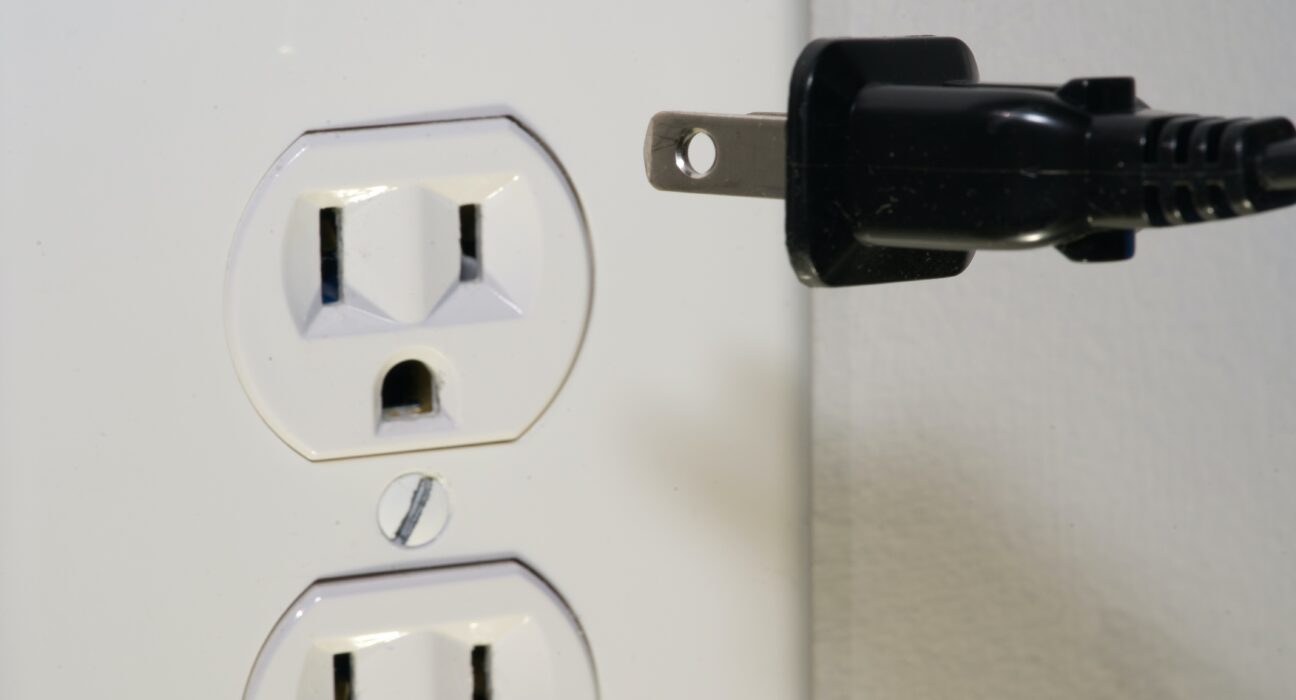If you’re traveling from the UK to the US or vice versa, one of the things you’ll need to be aware of is the difference in voltage and electrical systems. The UK uses a 230V, 50Hz system, while the US uses a 120V, 60Hz system.
This means that if you’re planning on using your electronic devices in the other country, you may need to take some steps to adapt them.
Reviewed by Electrical Engineer Mark Webster TMIET.
UK vs. US Electronics Terminology
One of the immediate barriers that comes with converting voltages and appliances across regions, is the language that is used. Here’s how British English and American English electronics terms translate.
| British English | American English | Meaning |
| Mains power | Wall power | The electrical power that comes from the outlet in your wall. |
| Earth connection | Ground connection | The safety connection that connects the metal frame of your device to the ground to prevent electric shock. |
| Flex/mains lead, mains wire/wiring | Power cord | The cable that connects your device to the outlet. |
| Pin, (plug) pin, prong, blade (plug) | Plug | The metal part of the power cord that goes into the outlet. |
| socket | socket, outlet, receptacle | The outlet that the metal part of plug goes into. |
4 Differences Between UK and US Electricity Systems
Looking at voltage and plug types can sound rather complicated. But there are actually only four differences between UK and US electricity systems.
1. Voltage
Voltage is the electrical pressure that pushes current through a circuit. It is measured in volts (V). The voltage in the UK is 230V, while the voltage in the US is 120V. This means that electronic devices that are designed for the UK will not work in the US without a voltage converter.
Example: A UK hair dryer has a voltage rating of 230V. If you plug it into a US outlet, it will receive 120V, which is not enough to power it. This could cause the device to malfunction.
2. Frequency
Frequency is the number of times per second that an alternating current (AC) changes direction. It is measured in hertz (Hz). The frequency in the UK is 50Hz, while the frequency in the US is 60Hz.
Example: A UK clock has a frequency rating of 50Hz. If you plug it into a US outlet, it will run 20% faster than it is supposed to. This is because the frequency in the US is 60Hz.
Some electronic devices, such as motors and clocks, are sensitive to frequency. Using a UK electronic device in the US with the wrong frequency can cause the device to malfunction or even break.
3. Plug Type
The plug type is the type of electrical plug that is used to connect a device to an outlet. The plug type in the UK is type G, while the plug type in the US is type A.
Example: A UK laptop has a type G plug. If you want to use it in the US, you will need a travel adapter to convert the type G plug to a type A plug.
If you have a UK electronic device, you will not be able to plug it into a US outlet without a travel adapter. The plug type in the UK is different from the plug type in the US.
4. Watts (By Product)
Watts is the unit of power used to measure the rate at which electrical energy is consumed or produced. It is calculated by multiplying the voltage by the current.
Example: A UK hair dryer has a wattage rating of 1000W. This means that it consumes 1000 watts of power when it is turned on.
When using a voltage converter, it is important to make sure that the voltage converter is rated for the wattage of the device you are using it with. If the voltage converter is not rated for the wattage of the device, it will overheat and eventually break.
How to Check the Voltage of UK & US Electronics
To check the voltage of an electronic appliance in the UK or the US, you can look for a label on the appliance that states the voltage rating. This label is typically located on the back or bottom of the appliance.
If you cannot find the voltage rating on the appliance, you can consult the appliance’s manual or contact the manufacturer.
The voltage rating will be listed in volts (V). For example, a UK appliance might have a voltage rating of 230V, while a US appliance might have a voltage rating of 120V.
It is important to consider the voltage rating of an electronic appliance when using it in a different country. If you use a UK appliance in a country with a lower voltage, such as the US, the appliance will not receive enough power and will not work properly. This can also damage the appliance.
Using Voltage Converters & Adapters on UK & US Appliances
If you need to use a UK device in the US or vice versa, you will need to use a voltage converter or adapter. A voltage converter changes the voltage from one country to another, while a voltage adapter simply allows you to plug a UK plug into a US outlet.
Travel Adapters
A travel adapter is a device that allows you to plug a plug from one country into an outlet in another country. Travel adapters are typically lightweight and inexpensive, and they can be purchased from most electronics stores.
To use a travel adapter, simply plug the plug from your device into the travel adapter and then plug the travel adapter into the outlet.
UK vs. US Travel Adapters
American travel adapters are typically rectangular in shape with two flat prongs. The prongs are parallel to each other and are spaced 12.7 mm apart. American travel adapters also have a grounding pin, which is a third, round prong that is located below the two flat prongs.

While British travel adapters are typically triangular in shape with three flat prongs. The prongs are arranged in a triangle pattern, with one prong at the top and two prongs at the bottom. British travel adapters do not have a grounding pin.

Converters & Transformers
A voltage converter is a device that changes the voltage from one country to another. A voltage transformer is a device that changes the voltage and frequency from one country to another.
To use a voltage converter or transformer, simply plug your device into the converter or transformer and then plug the converter or transformer into the outlet.
UK vs. US Converters & Transformers
American voltage converters are typically rectangular in shape with a plug and a socket. The plug is inserted into the electrical outlet in the country where you are using the converter, and the socket is where you plug in your device. American voltage converters also have a switch that allows you to select the input voltage and output voltage.
While British voltage converters are typically smaller than American voltage converters and have a different shape. They have a plug on one end and a socket on the other end, but the plug and socket are not rectangular. British voltage converters also have a switch that allows you to select the input voltage and output voltage.
Extension Lead Plugs
An extension lead plug is a device that allows you to plug multiple devices into a single outlet. Extension lead plugs are typically used to connect multiple devices to a single outlet, such as a computer, monitor, and printer.
To use an extension lead plug, simply plug the plugs from your devices into the extension lead plug and then plug the extension lead plug into the outlet.
Adapting Electronics for UK & US Systems
To adapt electronic devices for UK and US systems, you will need to use a voltage converter and a travel adapter. A voltage converter will convert the voltage from 230V to 120V (or vice versa), and a travel adapter will convert the plug type from type G to type A (or vice versa).
Here are some tips for adapting electronic devices for UK and US systems:
- Make sure that the voltage converter you are using is rated for the wattage of the device you are using it with.
- Do not overload the voltage converter or travel adapter.
- Do not use the voltage converter or travel adapter if it is damaged.
- If you have any questions or concerns about adapting electronic devices for UK and US systems, please consult an electrician or electronics expert.
How to Adapt Electronic Devices for UK & US Systems
Whether you’re adapting UK electronic appliances for use in the US, or the other way around, it’s important to know which is the right method for your product.
Devices That Require a Voltage Converter:
- Televisions
- Laptops and computers (unless they have a dual voltage power supply)
- Gaming consoles
- Printers and scanners
- Hair dryers (unless fitted with a voltage selector switch 230/120)
- Curling irons (unless fitted with a voltage selector switch 230/120)
- Coffee makers
- Toasters
- Kettles
- Blenders
To use the converter, simply plug the appliance into the converter and then plug the converter into the outlet.
Devices That Require a Travel Adapter:
- Smartphones and tablets
- Electric toothbrushes
- Shavers
- Hair dryers (if fitted with a voltage selector switch 230/120)
- Curling irons (if fitted with a voltage selector switch 230/120)
To use the adapter, simply plug the charger from your appliance into the adapter and then plug the adapter into the outlet.
Please note that this is not an exhaustive list and there may be other devices that require a voltage converter or travel adapter. It is always best to check the manufacturer’s specifications before using a device in a different country.
Should You Bring Electronic Appliances or Buy New?
Whether you should bring your electronic appliances with you or buy new ones when you move to the US or UK depends on a number of factors, including the cost of the appliances, the availability of similar appliances in the other country, and how important it is to you to have the same appliances that you are used to.
Appliances to Consider Bringing:
- Small appliances: Small appliances, such as hair dryers, electric toothbrushes, and coffee makers, are relatively inexpensive and easy to transport. If you have a special attachment to your favourite small appliances, or if you are moving for a short period of time, it may be worth bringing them with you.
- Appliances that are difficult to find: Some appliances, such as kettles and microwaves, may be difficult to find in the US or UK. If you rely heavily on these appliances, it may be best to bring them with you.
- Appliances that are important to you: If you have an appliance that is important to you, such as a family heirloom or a high-end appliance, it may be worth bringing it with you, even if it is more expensive.
Appliances to Consider Buying New:
- Appliances that are inexpensive: Large appliances, such as refrigerators, washing machines, and stoves, can be expensive to transport. If you are moving for a long period of time, it may be more cost-effective to buy new appliances in the other country.
- Appliances that are energy efficient: Energy-efficient appliances can save you money on your energy bills in the long run. If you are buying new appliances, be sure to look for models that are energy-efficient.
- Appliances that are designed for the local voltage: Appliances that are designed for the local voltage will operate more efficiently and will last longer. If you are buying new appliances, be sure to choose models that are designed for the voltage in the country where you will be using them.
Troubleshooting Common Adapter Issues
It is important to troubleshoot common adapter problems from the UK and US to the other regions. If you are having problems with your electronic device, there are a few things you can check:
- Make sure that the adapter is plugged in correctly.
- Check the voltage of the adapter to make sure that it is compatible with the voltage of the device you are using it with.
- Make sure that the adapter is powerful enough to run the device you are using it with.
- Try using a different outlet.
- Try using a different adapter.
If you are still having problems, you may need to contact the manufacturer of the device or adapter for assistance.
1. Device Not Working After Plugged In
If your electronic device is not working after you plug it in, there are a few things you can check:
- Check to make sure that the plug is fully inserted into the outlet and that the voltage converter is switched on.
- Try plugging the device into a different outlet.
- Make sure that the voltage converter is rated for the wattage of the device.
- If the device still does not work, try using a different voltage converter.
2. Device Overheating
If your device is overheating, unplug it immediately and allow it to cool down. Once it has cooled down, try connecting it to a different voltage converter or using a lower voltage setting.
If the device continues to overheat, it is best to contact the manufacturer for further assistance.
3. Device Malfunctioning
Some electronic devices, such as motors and clocks, are sensitive to frequency. Using a UK electronic device in the US with the wrong frequency can cause the device to malfunction or even break.
If your device is malfunctioning after being plugged into a voltage converter, try plugging it into a different outlet. If the device still malfunctions, it is best to contact the manufacturer for further assistance.
Electrical Safety Advice for Travelling Between the US and the UK
When traveling or moving to a new country, it is important to be aware of electrical hazards. Here are a few tips if you’re visiting the UK or the US:
- Use a travel adapter or converter to plug in your electronic devices.
- Do not plug multiple devices into the same outlet.
- Do not use extension cords.
- Be careful when using electronic devices near water.
- If you see any sparks or smoke, unplug the device immediately.
Final Thoughts from UK vs. USA
It is important to do your research before you move to a new country to make sure that your electronic devices will be compatible with the local voltage and plugs. If you are unsure, it is always best to err on the side of caution and bring a voltage converter and travel adapter with you.
If you found this article on voltage and electric appliances helpful, check out our article on the differences between UK and US keyboards.
Electrical Appliances, Voltage & Converters (UK vs. US) FAQ:
Can you use UK electrical items in the USA?
Yes, you can use UK electrical items in the USA with a voltage converter or a travel adapter.
Can I put a UK plug on a US appliance?
No, you cannot put a UK plug on a US appliance. The plugs are different shapes and sizes, and the wiring is different.
Do I need a voltage converter UK to the USA?
Yes, you need a voltage converter UK to the USA when using a UK electronic device in the US. The voltage in the US is 120V, while the voltage in the UK is 230V. Using a UK electronic device in the US without a voltage converter will damage the device.




